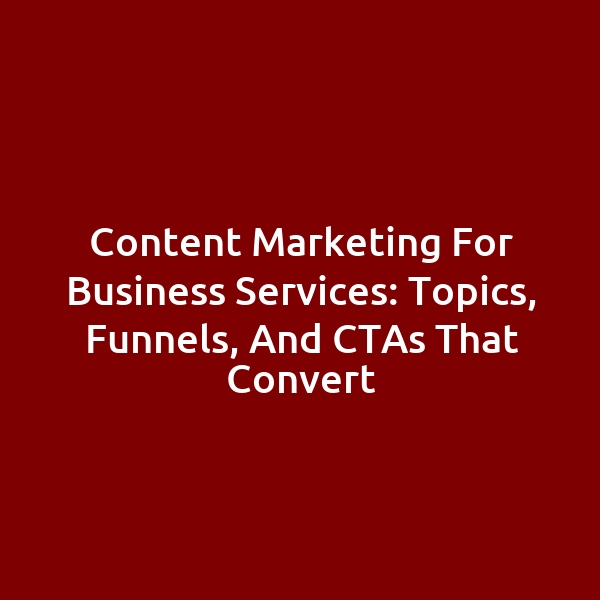In today’s digital age, content marketing has become an essential tool for businesses offering services. It is a strategic approach that focuses on creating and distributing valuable, relevant, and consistent content to attract and engage a clearly defined audience. The goal is to drive profitable customer action. This article delves into the intricacies of content marketing specifically for business services. We will explore effective topics, the structure of marketing funnels, and compelling calls-to-action (CTAs) that convert prospects into clients. By understanding these elements, businesses can enhance their marketing strategies, improve customer relationships, and ultimately increase their revenue.
Understanding Content Marketing for Business Services

Content marketing for business services differs from other sectors. It requires a deep understanding of the target audience’s needs and pain points. Businesses must create content that addresses these needs specifically.
Effective content marketing starts with identifying the audience. This involves segmenting potential clients based on demographics, behavior, and needs. This segmentation allows for more personalized content creation.
Once the audience is identified, businesses must decide on the type of content to produce. This can include blog posts, whitepapers, case studies, and more. The content should be informative, engaging, and tailored to the audience’s preferences.
Distribution is another key aspect. Content should be shared on platforms where the target audience is most active. This maximizes reach and engagement.
Measurement and analysis are crucial. Businesses need to track the performance of their content. This includes metrics like engagement rates, conversion rates, and customer feedback.
By understanding these elements, businesses can create a robust content marketing strategy that effectively promotes their services.
Choosing Topics That Resonate with Your Audience

Choosing the right topics is crucial in content marketing. The content must resonate with the audience to be effective. This involves understanding their interests, challenges, and needs.
Start by conducting audience research. Use surveys, interviews, and social media listening to gather insights. This helps identify the topics that matter most to your audience.
Consider industry trends and news. Topics that align with current events or industry shifts can capture attention and demonstrate thought leadership.
Look at competitors’ content. Identify gaps or areas where your business can add unique value. This can help differentiate your content from others.
Use keyword research to identify popular search terms. This can guide topic selection and ensure your content is discoverable online.
Regularly update and refresh content. This keeps your content relevant and valuable to your audience over time.
By carefully selecting topics, businesses can create content that engages their audience and supports their marketing goals.
Building Effective Marketing Funnels

Marketing funnels play a crucial role in guiding prospects through the buyer’s journey. They consist of different stages, each requiring specific content types and strategies.
The top of the funnel (TOFU) focuses on awareness. Content here should attract and inform a broad audience. Examples include blog posts, social media content, and infographics.
The middle of the funnel (MOFU) aims to engage and educate. This stage requires more detailed content like whitepapers, webinars, and case studies.
The bottom of the funnel (BOFU) is where conversions occur. Content here should persuade prospects to take action. This includes product demonstrations, free trials, and personalized consultations.
Each funnel stage should have clear goals and metrics for success. This helps track progress and optimize strategies over time.
Integrating automation tools can enhance the funnel’s effectiveness. These tools can personalize content delivery and streamline customer interactions.
By building effective marketing funnels, businesses can nurture leads and convert them into loyal customers.
Crafting Compelling Calls-to-Action (CTAs)

Calls-to-action (CTAs) are crucial for driving conversions. They guide the audience on the next steps to take after engaging with content.
CTAs should be clear and concise. They need to communicate the action you want the audience to take effectively.
Position CTAs strategically within content. They should be visible and relevant to the content being consumed.
Use persuasive language. Words like “discover,” “start,” or “get” can encourage action.
Test different CTA designs and placements. A/B testing can help determine the most effective approach.
Personalize CTAs where possible. Tailored messages can increase engagement and conversion rates.
By crafting compelling CTAs, businesses can enhance their content’s effectiveness and drive more conversions.
Analyzing and Optimizing Content Performance

Analyzing content performance is essential for continuous improvement. It helps identify what works and what doesn’t.
Use analytics tools to track key metrics. These include engagement rates, conversion rates, and traffic sources.
Conduct regular content audits. This involves reviewing existing content and identifying areas for improvement.
Gather feedback from the audience. Surveys and comments can provide valuable insights into content effectiveness.
Use data to guide content strategy adjustments. This ensures your content remains relevant and effective.
Stay updated with industry trends and best practices. This helps keep your content strategy competitive.
By analyzing and optimizing content performance, businesses can ensure their content marketing efforts deliver maximum results.
Conclusion: Key Takeaways for Effective Content Marketing

Content marketing for business services requires a strategic approach. It involves understanding your audience, choosing relevant topics, building effective funnels, crafting compelling CTAs, and continuously analyzing performance.
By implementing these strategies, businesses can enhance their marketing efforts. They can engage their audience, nurture leads, and drive conversions effectively.
Ultimately, a well-executed content marketing strategy can lead to increased brand awareness, improved customer relationships, and higher revenue.
Businesses should continuously adapt and refine their strategies. This ensures they remain competitive and meet their audience’s evolving needs.
Content marketing is a powerful tool for business services. By leveraging its potential, businesses can achieve long-term success and growth.
